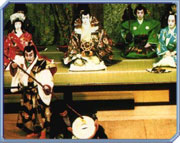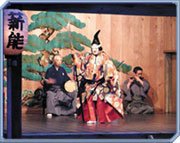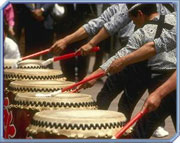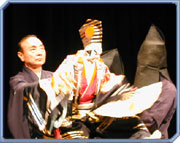 |
 |
 |
Packages focusing on the arts
Arts lovers will be well satisfied with a trip to Japan. The countryís relatively late opening to foreign influences have meant that the arts, particularly those of the theatre, have grown up in isolation making them quite different to those of other neighbouring countries in Asia.
Possibly the most famous of the performing arts is Kabuki. Developed in the early 1700ís the three Chinese character of Kabuki mean literally song, dance and action. The art form is rather eclectic and can combine elements of many different stories and styles of acting. One of the best places to see a performance is the Kabuki-za theatre in Tokyo. The theatre runs monthly programmes and has two different performances a day. English language translations are available giving visiting tourist some insight into why everyone around them is doubled over with laughter!





Kabukiís precursor was the drama known as Noh. A performance involves a large degree of stylisation and an often monotonous sounding vocal chanting known as Utai. There are a number of Noh drama schools in Tokyo where you can watch performances of this ancient yet fascinating art-form. However, a full-length 3 hour show often proves too much even for the most cultured of Japanese so we highly recommend just an excerpt.
All the major theatrical arts can be seen at theatres on Tokyo but it is also rewarding to tour some of the historic sights where these arts developed or are still performed in one form or another. Many small rural towns such as Komatsu in Ishikawa host childrenís kabuki festivals where abridge versions of longer plays are performed in the streets. Most of these festivals take place in the late spring and summer.
If you are interested in Bunraku puppetry, then it is definitely worth visiting the city of Tokushima on Shikoku where Ningyo-Joruri, a form of Bunraku was developed. Also of interest is the island of Sado which lies in the Japan Sea off the coast of Niigata. Sado was a prison colony and the notable Noh dramatist Zeami Motokiyo was exiled there in the 15th century. The islands close association with Noh Drama remains and the island houses a number of museums about the Drama. This is also the place to come if you would like to witness Taiko Drumming. The Ondeko drummers have their base on the island and drumming is performed during summer evenings along a form of dancing called Okesa.





For the pursuit of indigenous arts, the north island of Hokkaido will definitely be of interest. Ainu villages still exist where you can see examples of aboriginal costumes, dance, theatre and visual arts such as painting and carving. The Ainu have a long and fascinating history which has too long been overlooked. Their world is a magical one, governed by animal totems and spirits and this rich system of beliefs is more than evident in their artistic expressions.
Of course, theatrical arts are not the only art-forms well represented in Japan. Visual arts are of course well exhibited and collections include European artworks as well as traditional Japanese works. The most famous genre of Japanese visual art in the floating world of Ukiyo-e prints which first captured the imagination of the west in the 1800s. Developed in the Edo-period, these prints capture the essence of the daily lives of many Edo dwellers and were originally produced as book illustrations. The best collections can be found in the National Museum in Tokyo along with excellent examples of costume and sculpture.
For modern art, the place to head to is the National Park region of Hakone. Most visitors flock to the park to catch a glimpse of Mt Fuji, but if the weather is bad, then their visit can often be in vain. To accommodate and occupy the volume of visitors to the area, many privately owned galleries have come into being. The very best is the Hakone Open Air museum, a large open space where a fantastic and varied collection of sculptures are housed in a superb natural setting. Artists whose work is represented include Anthony Gormley, Henry Moore and Rodin.
Of course all of the major cities have modern art galleries but the most interesting and sobering the Museum of Contemporary Art in Hiroshima where the whole collection is dedicated to works that have been influenced by the atomic bomb attack. The works on display present a stark contrast to the traditional art forms usually associated with Japan and the museum is a challenging, yet wonderful place to experience.
BACK TO TOP
|
|
